Tell us about your research.
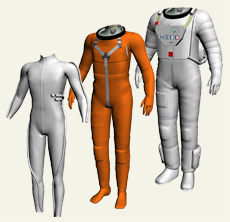
Structure of a next-generation advanced spacesuit. From left, the liquid cooling and ventilation garment, the pressure restraint garment, and the thermal micrometeoroid garment.
I am working on a next-generation advanced spacesuit. A spacesuit consists of three garment: closest to the skin is a liquid-cooling and ventilation garment, then a pressure-restraint garment, and finally the thermal micrometeoroid garment. I am responsible for the first and the last. The role of the liquid-cooling and ventilation garment is, obviously, to keep the body cool. The pressure-restraint garment maintains appropriate internal air pressure, and prevents air from leaking out of the suit. And the outside garment protects the human body from the extreme temperatures of outer space and from space debris. In space, the temperature reaches over 100°C in sunlight, and below -100°C without it. The difference in temperature is so great that extremely effective thermal insulation is essential.
Does the inside of a spacesuit get so hot that it needs cooling?
Because a spacesuit is sealed, it cannot dissipate the astronaut’s body heat, and the inside gets very hot. Without a cooling mechanism, the astronaut’s body temperature can keep rising, and that would eventually turn deadly.
How does the cooling undergarment work?
The current cooling garment works by circulating water through tubes all over its surface. But the one we’re designing at JAXA combines liquid-cooling and air-cooling systems.
Why do you need both?
Let me explain briefly how we got the idea. The United States developed the first spacesuit during the Gemini Program in the 1960s. It had an air-cooling system, using a fan to generate airflow that would dissipate heat. But that technology didn’t keep the astronaut cool enough. So NASA shifted to a liquid-cooling system, by running tubes through the garment and circulating cold water through them. That turned out to have another disadvantage: when an astronaut is working in space and getting hotter and hotter, he starts to sweat profusely, and cold water is not enough to evaporate the sweat. The sweat remains on the skin, and it feels sticky and unpleasant. So we thought sweat could be evaporated by blowing cool air on the liquid-cooling and ventilation garment, and we decided to use a combination of liquid cooling and air cooling.
Have you tested this technology on humans yet?

JAXA’s experimental liquid cooling and ventilation garment.
![]()
Working with a manufacturer, we made a liquid cooling and ventilation garment for research, and ran experiments with test subjects actually wearing it. We found the garment was still comfortable even after the person started to sweat, and its cooling performance was also good. JAXA’s cooling garment uses a cutting-edge material known as nanofiber, which can quickly absorb and evaporate sweat. This new material also improves cooling efficiency, as it enhances contact between the skin and the garment. Also, our liquid cooling tubes, which run through the surface of the garment, are about 30 percent shorter than those in NASA’s spacesuits.
Does that make the spacesuit lighter?
The tubing is only about 3 millimeters in diameter, so making it 30 percent shorter doesn’t make it much lighter. But with less tubing, the spacesuit becomes more mobile. Another advantage is that shorter tubing needs less water, which means less power consumption for the pump.
What is the ultimate goal of this research?
The goal is to get the technology to perform well enough that we can test a prototype in space. First of all, we want to keep the astronaut both cool and comfortable. Another goal is to reduce overall power consumption compared to conventional spacesuits. In addition to pumping liquids, our suit makes use of the fan that’s already used to circulate gasses to the life support system. Our research on this new cooling garment started five or six years ago, and is shaping up very well. We’ve already solved many problems, and now we’re just refining the technology so we will be able to build a prototype.
What do you mean by that?
For example, we would like to further simplify the connections between the liquid-cooling tubes. Some commercial cooling vests use only a single tube, but we use multiple tubes. By placing them in parallel, we can effectively cool down the whole body. But inevitably, there are many tube joints, which make the garment lumpy. Eventually we would like to simplify them.
What kind of uses can this garment have on the ground?
Through the JAXA Space Open Laboratory, which promotes the utilization of space technology for consumer products, there is an ongoing project to convert the garment for use by firefighters who work in very hot environments. We also think farmers could use the garment to prevent heat stroke when working long hours on a hot day.
Tell us about your research on the thermal micrometeoroid garment.
This research just started in 2011. We started by looking at how multi-layer insulation (MLI) is used in spacesuits. MLI has generally been used on satellites – the gold areas are MLI – and rockets. The Japanese Experimental Module KIBO has almost 20 layers of MLI. But if you put that many layers on a spacesuit, the material will be too thick for the astronaut to bend his arms. U.S. data shows that the performance of MLI is greatly affected by the size of the material and the sewing method, which means that a large piece of MLI and a small piece of MLI have different effectiveness. Sewing methods are different in Japan and the United States, so we had to figure out the minimum number of layers required, and the impact of sewing techniques on their effectiveness. Now that we’ve finished the analysis and test of this basic data, we are getting an idea of how we should use MLI.
And what about the protection layer?

Hole made when a projectile was fired at spacesuit fabric.
We are conducting simulation tests for collisions with micrometeorites and space debris using a material that is used in satellites and bulletproof vests. For instance, when a 0.5-mm aluminum projectile is fired at a U.S.-made material called Kevlar at a very high speed of 7 km per second, the bullet pierces through seven layers of it. That means that a spacesuit needs seven layers of Kevlar. But current U.S. spacesuits have only one or two layers.
That sounds odd.
Right. It doesn’t make sense. So our research began with the question, “Why so few?” As we experimented with many different materials, we finally found the answer. I can’t tell you about it now in detail, but a clue to the mystery was found in what is most important and fundamental for the protection layer. We now know more or less what material works best, and we are looking for the most appropriate weaving method for the material, and the best thickness and number of threads for sewing.
So the performance of a spacesuit is influenced by how it is sewn. I have heard that the U.S. spacesuits are not machine-made but handmade.
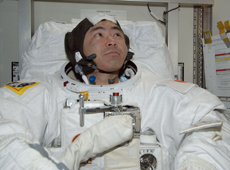
Astronaut Akihiko Hoshide trying on a spacesuit. The suit was handmade. (courtesy: JAXA/NASA)
Yes, it is well known that they are all made by skillful persons. A spacesuit incorporates many layers, so it can’t be sewn by machine. The insulation material, MLI, is very thin and flimsy – a spacesuit has about seven layers of it, with another layers of protective material on top. If you try to sew all this with a machine, it will get messed up. The material we used for research was square-cut, but for a real spacesuit, it comes in different shapes and sizes for different parts of the suit. They need to be sewn in multiple layers, so it has to be done by hand.
So, in order for Japan to make a spacesuit, you need to find the right sewing technique.
That’s right. For our spacesuit, we are trying to reduce the number of layers of MLI because we want to make the spacesuit as light and mobile as possible. At the same time, we also want to make it easier to sew and construct. If it’s difficult to make, there is no guarantee of quality. If quality cannot be guaranteed, it’s impossible to achieve the performance you designed, and that can cause many problems.
If it is difficult to make, why does that degrade the quality of a spacesuit?
The more complex the manufacturing process, the greater the chances of making a mistake. For example, let’s say that the suit’s effectiveness depends on how tightly it’s sewn. If the pieces get messed up in the sewing process, distorting the MLI, or tightening it too much in one place, that spot could end up leaking heat. To avoid such a possibility, we want to make our spacesuit as easy to sew as possible, by reducing the number of layers.
Do you think the technology you develop for the thermal micrometeoroid garment could be used for commercial products?
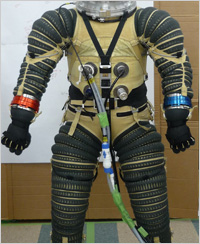
JAXA’s experimental pressure restraint garment.
Yes. You could apply the basic principles to insulation materials used in housing, for example. As for the protective layer, a bulletproof vest could be a candidate for this technology, but I think it will be difficult to make it happen right away. The reason is, a bullet keeps its shape even after it hits a bulletproof vest at a speed of 400 to 1,000 meters per second. But in the case of an aluminum projectile travelling through space at 7 kilometers per second, most of it evaporates the moment it hits the spacesuit. The destructive mechanism of these two objects is quite different. So I think it would be difficult to turn this garment into a commercial product immediately.
You are not directly involved in the research on the pressure-restraint garment, but how is that work going?
Currently, the internal pressure of the U.S. spacesuit is 0.3 atmospheres (atm) and that of the Russian spacesuit is 0.4 atm. Before doing a spacewalk, astronauts are required to spend hours slowly getting their bodies used to low pressure. This process is called pre-breathing, and it’s a great stress on the astronauts. With our spacesuit, the internal pressure we are aiming for is 0.58 atm, with a mix of 80% nitrogen and 20% oxygen, which will eliminate the need for pre-breathing. A pressure-restraint garment can inflate like a rubber balloon as its internal pressure becomes greater than the vacuum of space, but we would like to make a spacesuit that allows the wearer to move easily even with 0.58 atm. At this stage, the occupant can move considerably well with that pressure, but we are trying to make the suit more comfortable still.
What did you think of astronaut Akihiko Hoshide’s spacewalk last year?
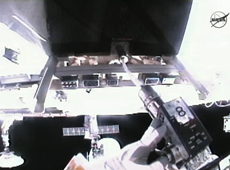
Cleaning a bolt hole with an improvised brush. (courtesy: NASA TV)
Astronaut Hoshide performed an unforeseen task due to a problem with an instrument. Speaking more broadly than just about spacesuits, tools are made with specifications to perform specific tasks. But I think that as long as we make things only to meet certain specifications, we won’t be able to respond to such unexpected needs. For example, if the spacesuit gloves had been made just to satisfy certain specifications, which defined the gloves’ objective as being able to grab only certain specific tools, the gloves may not have allowed astronaut Hoshide to hold the brush that he and the other astronauts improvised.
I see. The astronauts may be called upon to perform unforeseen tasks.
Exactly. But manufacturers are busy just trying to meet specifications. There are so many restrictions on things such as mass, size, mobility and durability, and the workers need to push themselves to the max just to meet these requirements. Earlier, when I was talking about the pressure-restraint garment, I said that an astronaut could move in a spacesuit with 0.58 atm considerably well. I said considerably for a reason. We have met the specifications we set for the research, but we are hoping to make the suit even more sophisticated, because, although it is possible to move in that spacesuit, it still takes a lot of strength. We want to make the suit even better.
Often, what has been done in the research is simply carried over to production as is. But watching astronaut Hoshide’s spacewalk, I had the profound realization that we have to think beyond just meeting specifications – we have to try to make things even better.
What was your specialty originally?
In school, my specialty was fluids. But at JAXA, in addition to fluid-related projects, I have been involved in many thermal-related projects, so people seem to have the impression that my specialty is thermal. I have worked on a heat-rejection system for the unmanned spaceplane HOPE (H-II Orbiting Plane); and the thermal control system, the environmental control and life support system, and the experiment support system for the Japanese Experiment Module KIBO. The thermal control system cools the electronics on KIBO using a fluid loop, and transfers the heated cooling water to the rest of the space station. And the environmental control and life support system maintains the temperature, humidity, air-flow velocity and hazardous gas concentrations in the astronauts’ work areas. Currently, in addition to spacesuits, I am researching technology for future manned spacecraft and life support systems.
You’ve done a lot.
Yes, I think so. In the case of HOPE, I was in charge of the flash evaporating system, which was part of the thermal control system. It was quite challenging, and I had a tough time. It was a device to spray and evaporate water in a vacuum for cooling. I used to spray water all day long, morning to night, every day, so eventually I became afraid of seeing even running tap water.
That must have been terrible!
I was pretty close to having a nervous breakdown (laugh). But, thanks to the experience of working on both spacecraft and spacesuits, I understand both. So I am now trying to unify the technology commonly used in these two areas. That way operations can be streamlined, and by helping each other we’ll be able to make even greater advances.
What led you to research on spacesuits?
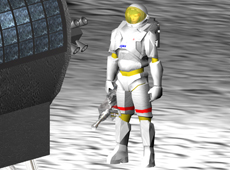
Early design drawing from JAXA’s spacesuit research team.
I was invited by one of my colleagues, who had launched a spacesuit research. The research took off at JAXA about six years ago, and I was asked to join the team about two years later. To tell you the truth, I was interested in spacecraft, but not at all in spacesuits. But the drawing of a spacesuit he showed me was very cool – it looked just like the Gundam suit. I thought, if they’re going to make such a cool spacesuit, I would love to be involved. And I immediately decided to join the team. (laugh) The spacesuit in the drawing was so beautiful, it had a huge impact on me.
Do you think the cool spacesuit in that drawing can become a reality?
Japan has technology, ability and ambition. And if we had enough budget, we could make it rather easily (laugh). I am confident that we can build a sophisticated spacesuit, but our budget is limited, so we have no choice but to find a middle ground. We may not be able to build that spacesuit right away, but we do always have the desire and ambition to make a stylish, high-performance spacesuit just like it. For instance, we are trying to reduce the number of layers of insulation material because we want to make the spacesuit slimmer.
You need money to make a dream come true. It’s frustrating, isn’t it?
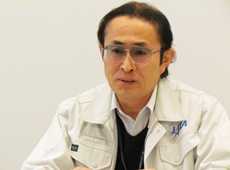
It’s not just us. For instance, if you ask whether Japan can build a spacecraft to go to the Moon, well, the country can’t afford the expense. It’s the same with the International Space Station. Fifteen nations got together to build it, because the U.S. didn’t have the budget to do it alone. Likewise, it’s possible that the next-generation spacesuit will be made through international collaboration. For example, the body of a spacesuit could be made by country A, with country B responsible for the life support system on its back. If this were to happen, we would like to have a spacesuit ready to pitch to the world. That’s the aspiration behind our spacesuit research.
Finally, could you share your vision of the future with us?
I am just dedicated to our current spacesuit research. I would like to make a good-looking, Japan-made spacesuit.
Associate Senior Engineer, JEM Mission Operations and Integration Center, Human Spaceflight Mission Directorate, JAXA
After graduate school, Mr. Aoki worked for a vacuum manufacturer and a heat-exchanger manufacturer, before joining JAXA. Later, he moved to a JAXA-related private-sector company, and is currently on temporary assignment with JAXA. He has worked on the flash evaporating system for the unmanned spaceplane HOPE; and the thermal control system, environmental control system, and experiment support system for the Japanese Experiment Module KIBO. Currently, in addition to the next-generation spacesuit, he is conducting research on manned spacecraft and life support systems. His specialties are fluid dynamics and heat transfer mechanics.
Go for Space!
A Mini Spaceship for One
Building a Good-Looking Spacesuit
Building a Better Spacesuit with Medicine
